

Guide05. Chapter 24-capacitance. The cylindrical and spherical E-field thrusters are violating Newton's 3rd law. Chapter 26 capacitance 26-1 Definition of Capacitance - ppt download. 6.3: Applying Gauss’s Law - Physics LibreTexts. 6.2: Explaining Gauss’s Law - Physics LibreTexts. We can now determine the electric flux through an arbitrary closed surface due to an arbitrary charge distribution.
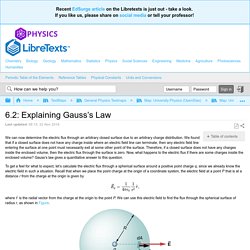
We found that if a closed surface does not have any charge inside where an electric field line can terminate, then any electric field line entering the surface at one point must necessarily exit at some other point of the surface. Therefore, if a closed surface does not have any charges inside the enclosed volume, then the electric flux through the surface is zero. Now, what happens to the electric flux if there are some charges inside the enclosed volume? Gauss’s law gives a quantitative answer to this question. ShowMe - Sphere. Physics 2113 Lecture 12: WED 11 FEB Gauss’ Law III Physics 2113 Jonathan Dowling Carl Friedrich Gauss 1777 – 1855 Flux Capacitor (Operational) - ppt download. Kirchhoff's rules. Now apply the rules to you circuit.Assume you connect a battery between A and B so that A is at some voltage V and B is at ground.

A current I will start flowing through the circuit from A to B. V=IR, R=V/I. If you know I, then you know R. To find R for your circuit we need to know the currents flowing through the 6 resistors. Wyzant Resources. Written by tutor Kate M.

Magnetic and electric fields The unification of electricity and magnetism in the mid-1800s by James Clerk Maxwell was one of the major scientific achievements of the 19th century. This unification showed us that while electric and magnetic fields differ in some significant ways, they are also intimately related. Recall that fields are just constructs we use to understand these ideas: we can’t see fields, but we can experience their consequences by way of their forces acting upon other objects.
In this article, we’ll learn about the magnetic field, magnetic forces, and the deep connection between magnetism and electricity. While electric fields are generated by electric charges existing at some position, magnetic fields are generated by moving electric charges. Difference between Electric field and Magnetic field. Magnetic Flux Motional EMF: moving wire in a B field - ppt download.
The Wonders of Electromagnetism. Vol.5Power Inductors in Mobile Phones There is also an Ohm's law for magnetic circuits Coils come in various shapes and configurations.
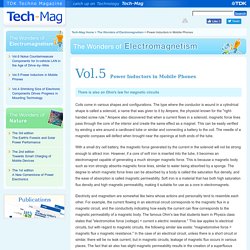
The type where the conductor is wound in a cylindrical shape is called a solenoid, a name that was given to it by Ampere, the physicist known for the "right-handed screw rule. " The Wonders of Electromagnetism. Vol.1 When did coils and electromagnets first appear?
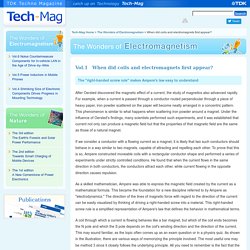
The "right-handed screw rule" makes Ampere's law easy to understand After Oersted discovered the magnetic effect of a current, the study of magnetics also advanced rapidly. For example, when a current is passed through a conductor routed perpendicular through a piece of heavy paper, iron powder scattered on the paper will become neatly arranged in a concentric pattern. This phenomenon is similar to what happens when scattering iron powder around a magnet.
Under the influence of Oersted's findings, many scientists performed such experiments, and it was established that current not only can produce a magnetic field but that the properties of that magnetic field are the same as those of a natural magnet. 9.3 Motors. HSC Physics Syllabus dot-point Summary - Motors and Generators - Dux College.
Motors use the Effect of Forces on Current-carrying Conductors in Magnetic Fields Factors affecting Magnitude of the Force on a Conductor.
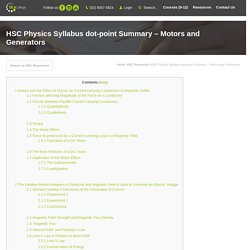
Electric motor - Physics - Metropolia Confluence. First we had to think of a really crucial technology concerning mankind.
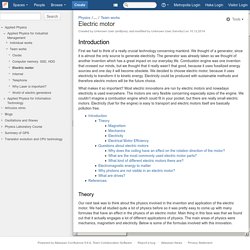
We thought of a generator, since it is almost the only source to generate electricity. The generator was already taken so we thought of another invention which has a great impact on our everyday life. Combustion engine was one invention that crossed our minds, but we thought that it really wasn’t that good, because it uses fossilized energy sources and one day it will become obsolete. We decided to choose electric motor, because it uses electricity to transform it to kinetic energy. Electricity could be produced with sustainable methods and therefore electric motors will be the future choice. What makes it so important?
DC Motor - MagLab. Electric motors turn electricity into motion by exploiting electromagnetic induction.

A simple direct current (DC) motor is illustrated below. The motor features a permanent horseshoe magnet (called the stator because it’s fixed in place) and an turning coil of wire called an armature (or rotor, because it rotates). The armature, carrying current provided by the battery, is an electromagnet, because a current-carrying wire generates a magnetic field; invisible magnetic field lines are circulating all around the wire of the armature. The key to producing motion is positioning the electromagnet within the magnetic field of the permanent magnet (its field runs from its north to south poles). Magnetic. The Right-hand Rules. The Right-hand Rules 1.

The first right-hand rule a. Used to find the direction of the field around a wire i. 2. A. I. 3. A. I. The Right-hand Rules. Right Hand Rules. Right-hand Rules. Fmagnetic - The force a magnetic field exerts on a moving charge The Right-Hand Rules apply to positive charges or positive (conventional) current Making illustrations of magnetic field and charge interactions in 3D Right-Hand Rule #1 (RHR #1) Right-Hand Rule #1 determines the directions of magnetic force, conventional current and the magnetic field.
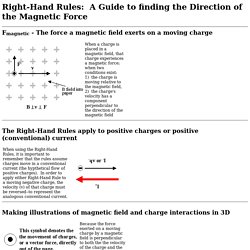
Given any two of theses, the third can be found. Cross Prosucts. Untitled. Physical Constants – The Physics Hypertextbook. General information - Worldwide supplier of cryogenic Hall probes. Hall probes have accomplished a rapidly growing demand in the past years, although, the Hall effect was discovered by Edwin H. Hall in 1879. Figure 1 shows principle of the Hall effect: Figure 1 Four leads are connected to the midpoints of opposite sides of semiconductor layer (e.g. InSb, InAs). Torque on a Current Loop: Rectangular and General. Electric field. In the equations describing electric and magnetic fields and their propagation, three constants are normally used. One is the speed of light c, and the other two are the electric permittivity of free space ε0 and the magnetic permeability of free space, μ0. The magnetic permeability of free space is taken to have the exact value. Wyzant Resources. Resistor Colour Chart. Untitled. Lab 2 Circuits. Department of Mathematics and Physics In this lab Ohm's law is verified and current flow in series and parallel resistive circuits is studied.
Internal Resistance, EMF and Potential Difference. In any circuit there are components that put energy in to the circuit and components that take energy out. From now on, we will say that any device putting energy into a circuit is providing an electo-motive force (emf) and any device taking it out has a potential difference (pd) across it.
Both emf and pd are measured in volts, V, as they describe how much energy is put in or taken out per coulomb of charge passing through that section of the circuit. Ohm's Law. There are certain formulas in Physics that are so powerful and so pervasive that they reach the state of popular knowledge. Experiment 3 - Ohm's Law. IGCSE PHYSICS: 2.10 describe how current varies with voltage in wires, resistors, metal filament lamps and diodes, and how this can be investigated experimentally. Electric Circuit Concepts. Electric Circuits. Student Learning Objectives Lessons / Lecture Notes Important Equations Example Problems Applets and Animations Student Learning Objectives To understand how current flows through conductors.
Parallel Circuits - Complete Toolkit. Electromagnet Calculator. Electric Energy and Electric Potential. Electric Circuits. Parallel Circuits - Complete Toolkit. How to Solve a Series Circuit: 9 Steps. Edit Article. How to Solve Parallel Circuits: 10 Steps. Edit Article. Mature, Sustainable, Multi-Hour Flywheel Energy Storage.
OLAB by C-DAC. Class 10 - ICSE Board - Mathematics, Science (Physics, Chemistry, Biology), Social Studies (Geography, History, Civics & Economics) - Study Material, Animated Videos, Summary, Questions and Answers, Wiki, References - LearnNext Online. LearnNext Lesson Video. OLAB by C-DAC. Virtual Lab High School. Circuit Construction Kit: Prototype Charges And Fields 1.0.3 Index of /sims/html. Kirchhoff's Rules. Next: Capacitors in DC Circuits Up: Electric Current Previous: Resistors in Series and We now know just about all that we need to know about emfs and resistors.
However, it would be convenient if we could distill our knowledge into a number of handy rules which could then be used to analyze any DC circuit. This is essentially what the German physicist Gustav Kirchhoff did in 1845 when he proposed two simple rules for dealing with DC circuits. Kirchhoff's first rule applies to junction points in DC circuits (i.e., points at which three or more wires come together). The junction rule is: The sum of all the currents entering any junction point is equal to the sum of all the currents leaving that junction point. This rule is easy to understand.
Kirchhoff's second rule applies to loops in DC circuits. Experiment Joule Report by. Fildia Putri. Physics - PhET Simulations. Balloons and Static Electricity Ohm's Law 1.3.7 Resistance in a Wire 1.2.8 John Travoltage 1.2.6 Ohm's Law 1.3.7 Ohm's Law is an interactive sim. It changes as you play with it. It has a Play Area and a Control Area. What is the potential difference/voltage in electrical engineering? Can anyone explain in simple terms? - Quora. Electric potential. Electric Potential – The Physics Hypertextbook.
Introduction Recall the developmental history of electrostatics. Charges exist. Charges exert forces on each other. This force appears to exert itself across distances of any size. Methods of charging. Static Electricity and Charge: Conservation of Charge · Physics. Superposition principle of electric field virtual experiment - Juany's Science Blog. Electrostatics. A pendulum bob of mass 80 mg and carrying a charge of 2000c is at. 100. Simple Electrostatic Experiments. OpenStax CNX. SAT Physics: Electric Force. The Best O Level revision resource. The Best O Level revision resource. Class 11 - Maharashtra Board - Mathematics, Science (Physics, Chemistry, Biology), Social Studies (Geography, History, Civics & Economics) - Study Material, Animated Videos, Summary, Questions and Answers, Wiki, References - LearnNext Online.